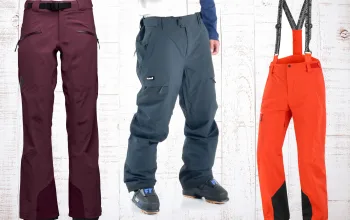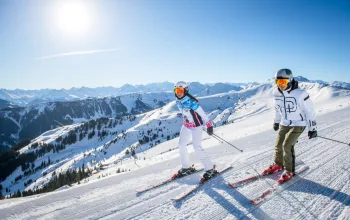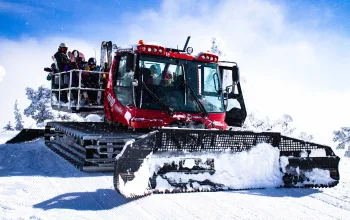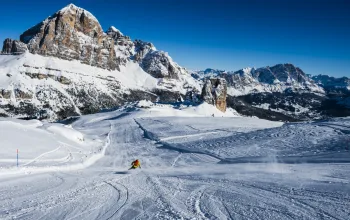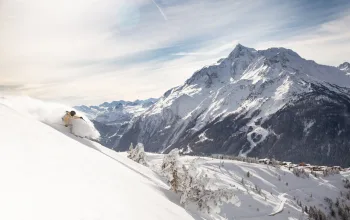How do you go about quantifying which are the best ski resorts in the world? We’ve spent hours debating this very subject at Snow magazine HQ. After all, while endless terrain, fantastic backcountry and brilliant slope-side restaurants all help resorts bag a few bonus points, the best resorts go one step further in a wide range of ways, so deciding which ones made the cut wasn’t exactly easy.
How do you weigh up, for example, the best ski resorts in Italy vs. the best resorts in Canada? Can you really compare a French mega-resort with an abundance of family-friendly pistes to a tiny two-lift operation in the backwoods of Colorado? And what about the towns? Do you prioritise ski-in, ski-out access, or chocolate box aesthetics? Is it all about the après, or about the growing number of fine dining restaurants popping up in ski resorts?
"This list might not solve all the debates—in fact, it's more likely to spark new ones"
To a certain extent, the answer to all of these questions is subjective. Some ski resorts are great for families. Some are ideal for beginners. Some are particularly well suited to off-piste powderhounds. In the end, everyone's idea of what makes the perfect ski holiday is slightly different, and we're not going to pretend that this list solves those all those debates (in fact, if anything, it's more likely to spark new ones).
What it does do, however, is represent the considered opinions of the Snow editorial team. Between us, we've racked up hundreds of years of skiing and snowboarding, and visited countless ski resorts on six of the seven continents (sadly, none of us has made it to Antarctica... yet).
Having compiled a long-list of over 100 resorts, from Avoriaz and Aspen to Zermatt and Zell-am-Ziller, we evaluated them on a wide range of factors including the quality of the skiing on and off-piste, the variety and the vibe of the town, the ease of access, prices and a multitude of other factors, including new lifts and services, and environmental initiatives. Finally, after much deliberation, we reached a decision. These, in alphabetical order, are our picks of the 25 best ski resorts in the world this winter.
- Alpe d'Huez, France
- Andermatt, Switzerland
- Cervinia, Italy
- Chamonix Mont Blanc, France
- Cortina d'Ampezzo, Italy
- Crans-Montana, Switzerland
- Erciyes, Turkey
- Hakuba, Japan
- Jackson Hole, USA
- Kicking Horse, Canada
- Laax, Switzerland
- La Grave, France
- La Plagne, France
- Madonna di Campiglio, Italy
- Morzine, France
- Mürren, Switzerland
- Obergurgl-Hochgurgl, Austria
- Powder Mountain, USA
- Red Mountain, Canada
- Saas-Fee, Switzerland
- St. Anton, Austria
- Telluride, USA
- Val di Fassa, Italy
- Verbier, Switzerland

Alpe d’Huez, France
Known as “l’Ile au Soleil,” thanks to the town’s south-facing aspect, Alpe d’Huez has long been a favourite for family ski holidays. But there’s more to this mega-resort than just kid-friendly greens and cruisey blues. Its vast ski area links four separate villages and contains some pretty serious off-piste, as well as La Sarenne, the longest black run in France. It’s snow sure too, with lifts reaching up to the 3,300m-high summit of Pic Blanc.
Down in town, the architecture reflects every era of French ski resort development, from traditional farmers’ cottages to the more ‘adventurous’ brutalist creations of the 60s and 70s. But it’s not short on historical charm—the first lift opened here in the 1930s, making it one of Europe’s oldest resorts, and of course, its switchbacks are the stuff of cycling legend.
If it’s après you’re after, Alpe d’Huez checks that box too. It hosts the Alps’ biggest music festival, Tomorrowland Winter, every March, attracting more than 20,000 attendees.
Read our full resort review of Alpe d'Huez here.

Andermatt, Switzerland
Once a sleepy Alpine village, Andermatt was bought by US conglomerate Vail Resorts in 2022, and the company’s deep pockets means there’s a lot of investment—and some big changes—on the horizon. Vail Resorts has promised pump 110 million Swiss francs (£95 million) into improving the ski area infrastructure, and the company has allocated a further 39 million francs (£33 million) for real estate developments in the village itself.
Of course, none of this would be worth diddly-squat unless Andermatt had the natural assets to make it worthwhile. Luckily, it was already one of the best ski resorts in Switzerland, in our opinion, with extensive and varied terrain. There are 180 kilometres of slopes, 33 lifts and numerous peaks over 3,000 metres. In 2019, a gondola was built linking Andermatt’s ski area with nearby Sedrun, expanding the ski area even further.
While intermediates who will be most at home here, it's also something of a Mecca for freeriding. The Gemsstock is home to all manner of steep and gnarly descents. It helps too that Andermatt is one of Europe’s most snow sure resorts, because of its position, which means it gets snow from both the south and the north.
Read our guide to Andermatt ski resort here.

Amirsoy, Uzbekistan
It might seem a bit far-fetched to claim that Amirsoy, a new development in the Central Asian nation of Uzbekistan, is one of the best ski resorts in the world. But we reckon give it a few years and it could be. And we can honestly say that of all the ski destinations the team has visited recently, this is the one that excited us the most.
Built in world record time at a cost of £75 million, Amirsoy marks the first attempt to construct a modern resort with French-made lifts, German piste-bashers, and Austrian standards of safety in the region. It's still early days - the resort opened in late December 2019 - but the plans for this place are big, and with the country opening up to tourists and the abolishment of the previously draconian visa requirements, it's significantly easier get to.
As anyone who's been skiing in neighbouring Kyrgyzstan or Kazakhstan will be able to tell you, the dry powder of the Tien Shan mountains really is like nothing else you'll ever experience. Which is why we've marked Amirsoy as "one to watch". Or, if you fancy heading a little further off the beaten track for your next ski holiday, one to head to as soon as possible.
You can read the full story of our trip to Amirsoy here.
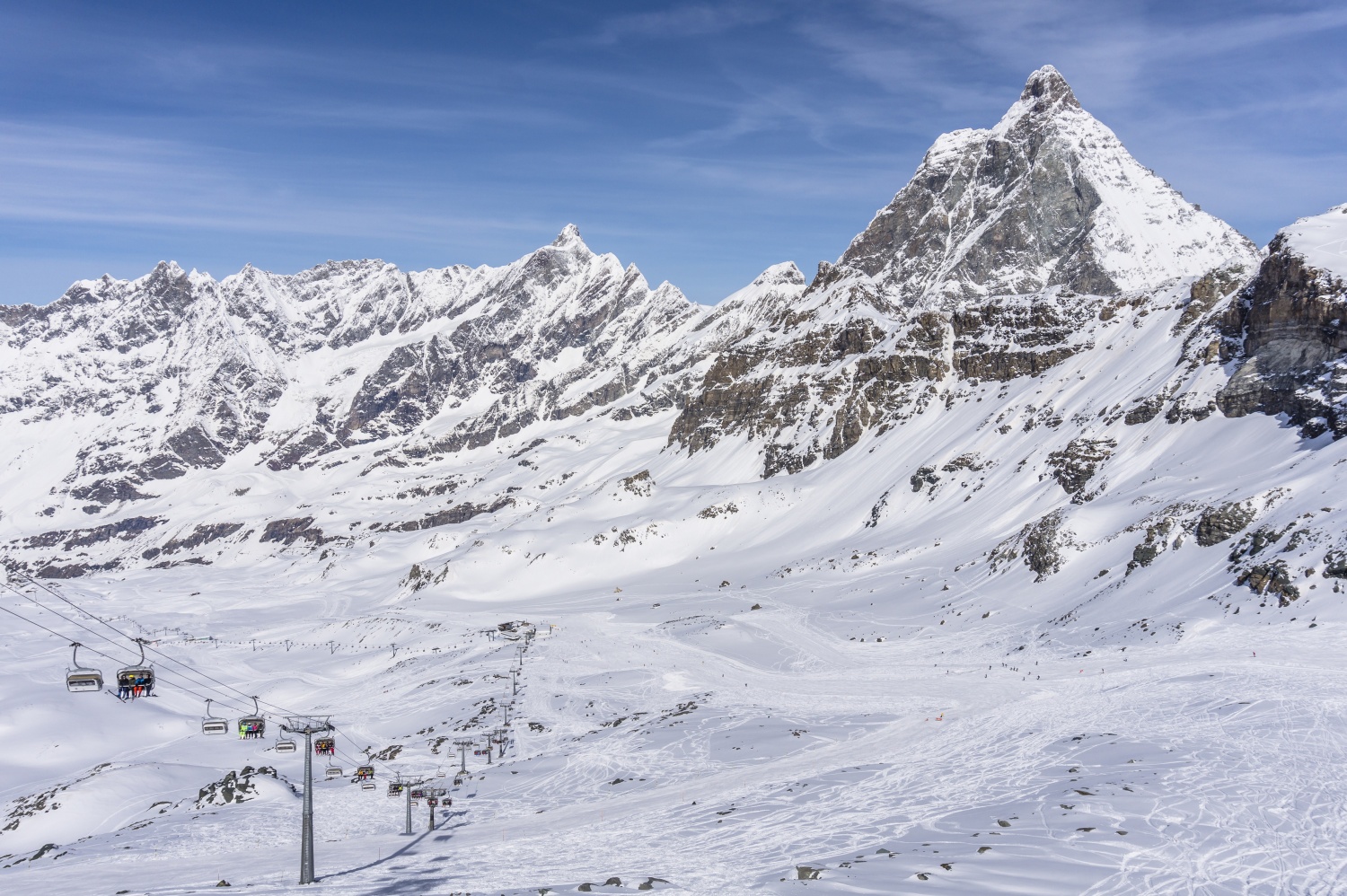
Cervinia, Italy
Cervinia has always been linked to its neighbour Zermatt, one of the best ski resorts in Switzerland, via the slopes. But now there's one more, massive reason to visit this fantastic Italian ski resort: Opened in July 2023 the brand new, high-speed Matterhorn Alpine Crossing allows you to travel from one resort to the other, and reach heights of 4,000m, without even setting foot on the pistes, (should you wish). The new connectivity makes crossing between the two far quicker, benefitting skiers and non-skiers alike.
Other reasons to visit Cervinia include the ridiculously long winter seasons (ski lifts typically operate from late October until early May), its sustainability credentials (you’ll find some of Italy’s finest examples of bio-architecture here) and the huge ski area. One of our favourite bits is the Indianpark snowpark, which you’ll find at the foot of Monte Cervino (the Italian name for the Matterhorn). Its various obstacles – both manmade and natural - make it a magnet for some of the world’s best skiers and snowboarders. We’re also huge fans of the park’s chillout zone, the highlight of which is the barbecue area.
Prefer to stick to the regular slopes? You’re in luck. You’ll have over 150 kilometres of slopes to explore—rising to 360 kilometres if you include Zermatt. The majority of these are best suited to intermediate skiers, with a great network of easy blues which connect directly to the resort’s centre. The large Plan Maison beginner's area is perfect for skiers taking to the snow for the first time. Some of the more challenging terrain can be found close to the Swiss border, while the ludicrously long runs which lead all the way down to the historic village of Valtournenche will appeal to those who love a ski safari.
Read our guide to Cervinia ski resort here.
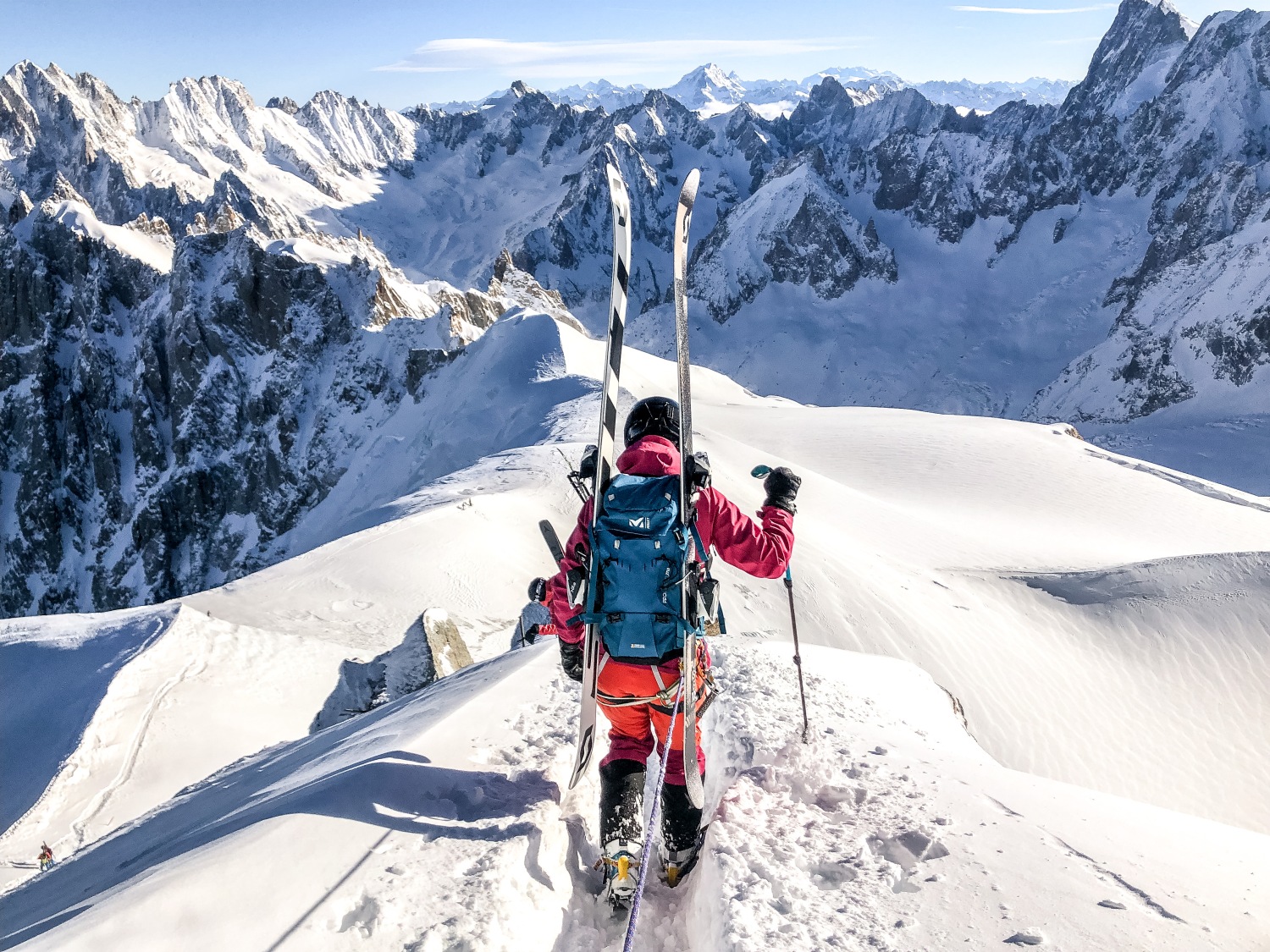
Chamonix Mont Blanc, France
It might feel like a cliché to include Chamonix, but it's hard to argue this legendary resort isn't worthy of a spot on this list. Famous for the diversity of its terrain, the reliable snow conditions, huge ski area, and incredible views of the tallest mountains in Europe, including, of course Mont Blanc. The high altitude terrain here is obviously world-renowned, but this is also where you’ll find some of Europe’s best tree runs, complete with mellow side hits (one of the reasons French snowboarder Arthur Longo, the viral video king of side hits, lives here).
It might be best-known as a destination for serious skiers, but the reality is whatever level you're at you'll find your dream stomping ground in the combined terrain of Chamonix's five main ski areas — Brevent, Flegere, Grands Montets, Domaine de Balme and Les Houches.
Then there's the resort itself, which is less an alpine village than a proper town — with facilities and amenities you won’t find in any other ski resort. Its proximity to Geneva and the airport, which you can reach in just over an hour, means the permanent residents are a more cosmopolitan crowd than you'd find in many places in the French Alps. This is reflected in the resort's bars, which are hugely varied.
Finally, there’s its history. Chamonix has been a winter holiday town since the late 1700s, when it was a staple of the Grand Tour which young aristocrats took around Europe. How many other ski resorts can boast that they've played host to people like Keats, Shelley, Mary Shelley and Lord Byron? The presence of Mont Blanc means that much of the history of mountaineering has been written in Chamonix, and alpine skiing was essentially invented here—the first ski lift was installed here in the early 20th century, and next year marks the 100th anniversary of the the first Winter Olympics, held right here in 1924.
Read our full resort guide to Chamonix Mont Blanc here.

Cortina d’Ampezzo, Italy
If resort ratings were based on looks alone, Cortina d’Ampezzo would win hands down. It’s surrounded by the impossibly-picturesque peaks of the Dolomites, while the town itself, with its 19th century centre and pedestrianised main street, is one of the oldest and most attractive ski villages in Italy.
While not all the ski areas are linked by lift, there’s a vast amount of terrain on offer locally, and the Dolomiti Superski Pass gives you access to dozens of resorts and 1,200km of slopes—more than any other day or week-long pass in the world. Plus, there’s the Hidden Valley of Lagazuoi—a true bucketlist run.
During Italy’s postwar boom years, Cortina was the place for well-heeled Venetians to be seen in winter. It drew the eyes of the world when it hosted the 1956 Winter Olympics, and excitement is already rising for the return of the Games next year. Add in arguably the classiest collection of restaurants and cocktail bars in any resort and you can see why Cortina was a shoe-in for this list.
Read our full resort guide to Cortina d'Ampezzo here.

Crans-Montana, Switzerland
It might be a new entry on this year's list, but we've always rated Crans-Montana one of the best ski resorts in Switzerland. The thing that's catapulted it into the big leagues as one of the best resorts in the world this year is a change of ownership—marking perhaps the most significant shift in the resort's history since the wave of post-war construction that created Crans-Montana as we know it today.
At the beginning of last December, the US conglomerate Vail Resorts announced that it had acquired an 84 percent ownership stake in company which controls and operates all the resort's lifts and mountain operations, including four retail and rental locations. The company had also bought one of the ski schools and all of the 11 restaurants located on and around the mountain. The amount they paid was undisclosed, but they estimated the total worth of their new holdings as CHF 118.5 million (£105 million).
In order to help the deal over the line, Vail Resorts promised big investments, including CHF30 million (£26 million) over the next five years. Like Andermatt, just up the road, which Vail Resorts bought in 2022, this means a change is gonna come to Crans-Montana — with new and improved snow making, lifts and pistes and hefty investments in guest services and gastronomy.
At the same time, Vail have promised not to mess with what made Crans-Montana special in the first place. The resort has a long and rich skiing history—over 100 years of it, to be precise. The first funicular opened in 1911, and that same year, the Edwardian ski pioneer Sir Arnold Lunn organised the first ever downhill race, with a dozen or so members of his Kandahar Ski Club. You can still feel this heritage down in the pretty town, while the mountain itself offers a vast, varied and snow sure ski area, with a 1,500m vertical drop and some of the best views in Switzerland.
Read our full review of Crans-Montana here.

Erciyes, Turkey
Although it’s one of the world’s most popular summer holiday destinations, Turkey isn’t exactly full of famous ski resorts. But Erciyes easily earns its place on this list thanks to its amazing location, incredible terrain, and ludicrously low prices. Plus, of course, the ready availability of Turkish food.
Built around three sides of Mount Erciyes, a spectacular extinct volcano with a collapsed crater at its summit, this relatively new resort (built since 2005) boasts 150km of pistes. These are served by 12 high-speed, Austrian-made lifts, the highest of which tops out at 3,400m—higher than the top station in Val Thorens. The lifts are widely spaced too, leaving plenty of space for powderhounds to plunder easy, sidecountry runs.
The upmarket hotels in the resorts’ base areas are international standard, but it’s arguably more fun to stay in the ancient city of Kayseri, just half an hour down the road. Cappadocia, home to the iconic “fairy chimneys” and a UNESCO World Heritage site is only an hour away too—easily reachable on a down day. Oh and did we mention the liftpass prices? A day’s skiing will set you back the princely sum of 430 Turkish lira—which is just under £10.
You can read the full story of our trip to check out Erciyes, and Turkey's skiing scene, here.

Hakuba, Japan
Japow, the soft, fluffy, delicacy cooked up by the unique weather systems over the sea of Japan, is undoubtedly best enjoyed on the country's northernmost island. That said, there's still plenty of the white stuff to be found further south. Take Honshu, Japan's main island, which lays claim to the kind of couloirs and steeps that Niseko and the other famous resorts further north can only dream of.
Hakuba, one of the larger mountain towns in the range, offers easy access to several ski areas, including Happo One, Norikura Onsen and the slightly confusingly-named Cortina. Between them, these slopes offer pistes for every skill level, along with a huge variety of backcountry lines.
The terrain around here would be reason enough to visit, but there’s another reason to visit the Japanese Alps - because they're not as famous, they tend to attract fewer foreigners. So while an après ski bar in Niseko is just as likely to be owned by an Australian as a local, in Hakuba, it's easier to enjoy an authentically Japanese cultural experience - which, let’s face it, is wehy most people come skiing in Japan in the first place.
Read our full Hakuba resort guide for more info.

Jackson Hole, USA
In a remote corner of Wyoming, the least populous state in America’s ‘Lower 48’, lies Jackson Hole. It’s a long way away from the mainstream mega-resorts of Colorado and Utah, both in geography and in spirit. Unlike much of the Rockies further south, the terrain in the Teton Range is genuinely steep. The fact that much of it is “in bounds” (and therefore patrolled, unlike off-piste terrain in the Alps) doesn’t make it any less challenging.
The town has moved a long way upmarket since skiing replaced ranching as the main source of income. But the ethos of the original frontiersmen lives on in pioneering locals like the boundary-pushing snowboarder Travis Rice, or the team behind the world-famous Teton Gravity Research films.
Sure, there are luxury condos and pricey restaurants aplenty these days—particularly around the slopeside settlement of Teton Village. And yes, former Vice President Dick Cheney has a home here. But Jackson still attracts enough of skiing’s lunatic fringe to keep it interesting—and the ride-hard, party-hard atmosphere is a big part of the allure.
Read our full ski resort review of Jackson Hole here.

Kicking Horse, Canada
Home to the only North American leg of the Freeride World Tour, Kicking Horse has long been famous for its off-piste. The ski area includes 3,500 acres (1,416 hectares) of skiable terrain, offering 4,314 feet (1,314m) of vertical, 121 runs, and 85 marked couloirs, accessed by five lifts. The terrain is laid out across five bowls which were once only accessible by helicopter, and offers plenty of variety.
As is customary in North America, the bulk of the best backcountry terrain here is "in-bounds", meaning it's patrolled and controlled for avalanche risk. This also means the routes are marked, and Kicking Horse's trail map includes numerous black diamond and double black diamond runs. The snow here is incredibly consistent, with an average of about 7m falling each season, and because it's miles from the sea (the nearest coastline is 489 kilometres away), it stays dry days after a dump.
Having said that, it's not all about the gnar here. The lower flanks of the mountains, accessed via the Catamount lift, offer easy green runs that loop through the trees: perfect for beginners. You can stay in the tiny purpose-built ski resort village at the base of the mountain, or for the true Canadian Rockies experience, in nearby Golden, a 19th Century railway town that still maintains a healthy dose of its original charm.
Driving, of course, also gives you the flexibility to explore the rest of the ski resorts on the Powder Highway. While Kicking Horse is the pick of the bunch, Revelstoke, which is just nearby, Red Mountain, and Whitewater, further south, are all well worth a visit.
Read our full Kicking Horse resort guide for more info.

Laax, Switzerland
In the early 90s, Reto Gurtner, who essentially inherited the Swiss resort of Laax from his father, made a bold choice: to differentiate it from their countless competitors in the canton of Graubunden, the resort would bet big on the new-fangled sport of snowboarding—building one of Europe’s first halfpipes, investing in an extensive terrain park, and hosting the European Open each year. Gurtner had learned to surf while studying in San Francisco in the 70s, and believed freestyle was the future.
In the years since, the bet has paid off in spades as Laax has become the European destination for international pros to hang out and train—and not just snowboarders, but freestyle skiers too. But there’s more to this resort than just its freestyle facilities. The ski area is vast with 224km of pistes; there’s a wealth of incredible backcountry terrain, and the village has something of a West Coast, California vibe that sets it apart from anything else in the Alps.
However, the real reason it makes this list (as well as our list of the best ski resorts in Switzerland), is Gurtner’s latest big bet: Laax is aiming to become not just net-zero, but actual zero carbon by 2030—a world first. Their lifts and snow cannons are already powered by renewables, and they’re investing more in things like building insulation and electrified piste bashers each year. This winter, they’ll fully open the world’s first “on-demand” gondola—another emissions-saving innovation. In a world of greenwashing, Laax is the real deal.
Read our full ski resort review of Laax here.

La Grave, France
It might seem perverse to include a place with only one lift and fewer than 500 visitor beds and on this list. But for a certain kind of skier, resorts don't get much better than La Grave. It might be one of the smallest ski towns in France, but La Grave is one the best places on the planet for freeriding. Think Chamonix, without the crowds, or Jackson Hole, but with gnarlier descents.
La Grave’s only lift is a now iconic cable car made up of five brightly-coloured bubbles that stretches from the village at 1,500m to Les Ruillans at 3,200m. There’s nearly 2,000m of vertical descent, but no marked pistes. It's all just backcountry, left as God intended, for brave skiers to descend in whichever way—and however fast—they see fit.
The village is a no-frills affair mostly made up of hotels from the 70s, and the closest you get to “ski in, ski out” accommodation here are the vans lined up in the carpark. There can be a lively après ski scene in La Grave—but if the snow's falling, the bars will be empty.
Read our full ski resort review of La Grave here, and the account of our most recent visit here.

La Plagne, France
By some measures, La Plagne is the largest ski resort in the world, yet it is often strangely overlooked— written off as just a family friendly destination, whose runs are too flat for serious skiers ("plagne" is a variation on the French word for "flat"). The truth could not be more different. While there are flat sections, the resorts vast ski area, arranged around 11 villages, has literally every terrain type you could possibly wish for—from the tree runs near Montchavin, to the high alpine glacier skiing beneath the 3,417m high peak of Bellcôte.
If the resort's 225km of pistes somehow aren't enough, it's also linked to neighbouring Les Arcs, offering access to a further 200km on the other side of the chasm-spanning Vanoise Express gondola. Between the two, meanwhile, lies one of France's great off-piste runs, the 2,000m-long Face Nord du Bellcôte.
Of course, none of these natural riches are new—the mountains of La Plagne haven't changed since the resort opened in 1961. The villages, meanwhile, still maintain that 1970s moon-base aesthetic that characterises so many high altitude French resorts of the era. What's earned La Plagne place on the list of the best resorts in the world this winter is a big new lift development—a €26 million (£22 million) gondola project that will carry guests up to a café overlooking that famous North Face.
The lift will not only make skiing in the highest, most snow sure area of the resort a lot easier, it will open up masses of new, expert terrain—perhaps helping to put La Plagne's reputation as "mostly a beginners'" resort to bed for good.
Read our full resort review of La Plagne here.

Madonna di Campiglio, Italy
If Kicking Horse is the archetypal Canadian mountain resort, nowhere sums up skiing in Italy quite like Madonna di Campiglio. Italians from further south will try and convince you that people from the Trentino region are practically Austrian, such is their proximity to the Tyrolean border, but don't believe a word of it.
Stereotypes are two-a-penny on the slopes here, from women in fur coats and Gucci sunglasses, to the best-dressed snowboarders you'll see anywhere in Europe. But this is precisely Madonna's charm. Crystal Ski Holidays have the resort on their books, but you're unlikely to run into many Brits. In other words, if you’re after the ultimate Italian alpine experience, it doesn’t get better than this.
Let’s start with the mountains. The Dolomites are famously stunning, but the peaks around Madonna, the Dolomiti di Brenta, are particularly beautiful. Jagged, red rock spires capped by bright white snow and flanked by forests of dark green pines. The ski area is large - the fifth largest in Italy, with over 150km of marked piste. At the top of the Grosté lift, you'll find the Ursus Snowpark, one of the best terrain parks in the country, if not the whole of Europe.
While the off-piste in the Madonna ski area isn't world-class, the nearby resort of Passo Tonale, which can be accessed on the same Superskirama ski pass, boasts some of Italy's best lift-accessible backcountry. As you'd expect, the food both on and off the hill is second to none. And while Madonna isn't the cheapest by Italian standards, it's still a snip compared to the most of the ski resorts in France. With the cost of living crisis making price a key concern for many this winter, this is all the more reason to include it in our list of the world's best ski resorts.
Read our full Madonna di Campiglio resort guide for more info.

Morzine-Avoriaz, France
What can be said about Morzine-Avoriaz which hasn't already been said a million times? One of France's most famous ski resorts - particularly among Brits - it combines competitive prices with one of the biggest ski areas in the world. Quite simply, there's something for everybody in the Portes du Soleil.
The 650km of lift-linked pistes, which stretch across the border between France and Switzerland, make this a magnet for fans of everything from high alpine skiing to blue run cruising. There are plenty of snow parks for freestyle skiers and snowboarders, while fans of off piste skiing will drool at the range of accessible backcountry terrain on offer — more than you could ever explore in a lifetime.
Admittedly, the popularity of this vast ski area means that there are occasionally bottlenecks on the most popular ski lifts – particularly those in the resort itself, but there’s a reason to many visitors choose to base themselves in the centre of Morzine. A proper town, rather than a purpose-built ski resort, it's got a year-round population and plenty of independent businesses run by locals, including an excellent local craft brewery, the Bec Jaune.
Somehow, the town has managed to avoid the worst of the imitation Bauhaus building spree which swept through France in the seventies, and it's maintained its traditional, wooden chalet vibe. And while the British presence is strong (the fashion-conscious seasonaire set has even earned it the hipster sobriquet of 'Shorezine,' after London's Shoreditch) it hasn't overwhelmed what made this ski resort great in the first place.
Read our full Morzine resort guide for more info.

Mürren, Switzerland
In what is, by definition, a crowded field, Mürren has to be a top contender for the ski resort with the best views in the world. From the resort’s centre it’s possible to see not just one, but two 4,000 metre peaks, the Mönch and the Jungfrau, as well as the forbidding form of the Eiger—one of the world’s most famous mountains.
This hat trick of high altitude awesomeness sits at the heart of what's known as the Swiss Alps Jungfrau-Aletsch UNESCO World Heritage site. The railway which accesses it is insane feat of alpine engineering which culminates at the Jungfraujoch, Europe's highest station at 3,454 metres and resort’s most Insta-friendly spots. Prefer skiing over selfies? You’re in luck.
It’s a brilliant ski resort for families, with fast ski lifts and slopes suited to all ability levels, but the ski area boasts plenty for properly avid skiers too. The Kandahar Ski Club, one of the first ski racing clubs in the world, was formed here in 1924. Meanwhile, the Inferno Race, a 2,000 metre descent from the top of the Schilthorn down to the village of Lauterbrunnen, is one of the great historic alpine challenge and has taken place since 1928.
The nightlife might not rival the après ski scenes in larger ski resorts, but if you've come to Mürren for the après, you've kind of missed the point. This ski resort is all about giving visitors - skiers and non-skiers alike - a taste of traditional Switzerland, and as a place to soak up alpine culture, it doesn't get much better.
Read our full Mürren resort guide for more info.

Obergurgl-Hochgurgl, Austria
Whittling down the world's best ski resorts into a manageable list is a near impossible task—as is shown, very obviously, by the fact that this is the only one of Austria's excellent resorts to make the cut. Yet if you have to choose just one ski resort which represents the all the best bits of the Austrian Alps, we'd argue that Obergurgl-Hochgurgl is a pretty strong contender.
A high altitude ski resort with snow sure slopes, this twin-resort skiing destination has everything from challenging and high alpine off piste terrain, to cruisey blues and laidback tree runs. There's an extensive network of cross country trails, and the two towns - and the scattered mountain huts between them - provide plenty of opportunities for schnapps-fulled après ski celebrations Austria is famous for.
Prices are refreshingly low - especially compared to skiing in France or Switzerland – and if you buy a lift pass for longer than three days here, you automatically get access to the entire Ötztal area. This includes the resort of Sölden, just a short bus ride away (and where you can dial the nightlife up to 11, should you so wish) and the tiny, oft-overlooked village of Vent. The latter only has a handful of lifts, but they offer access to one of the best ski touring areas in the Alps, and multiple mountain huts. That kind of variety, at Obergurgl-Hochgurgl prices, is hard to argue with.
Read our full Obergurgl resort guide for more info.

Powder Mountain, USA
Here's a good pub quiz question: What's the biggest ski resort in North America? Most people would probably bet on Whistler-Blackcomb, the Canadian mega-resort north of the border. But the real answer, at least in terms of accessible in-bounds terrain (which is how they measure such things over the pond) is a humble little place called Powder Mountain, just outside a tiny village called Eden, in Utah.
Powder Mountain has an incredible 8484 acres (3433 hectares) of skiable terrain, accessed by a mixture of lifts and snow cat tows. Like most US resorts, the chairlifts are old and slow compared to the ones you find in Europe. But the resort's slogan is "uncrowded by design" and the place doesn't really suffer from queues. Best of all is the light, fluffy snow that gives the place its name. The resort gets an average of nine metres a season—all of it the kind of moisture-light powder that Utah's tourist board likes to claim is "the greatest snow on Earth."
As a resort, Powder Mountain doesn't look like much. The base station is little more than a carpark, a guides' office housed in a yurt, and a saloon-style après ski bar call the Powder Keg. But Eden, Huntsville or one of the other nearby villages are full of rural charm and packed with stereotypical Americana. If you're looking for a American ski holiday experience that's less polished, but arguably more authentic, then PowMow, as the locals call it, should be on your list.

Red Mountain, British Columbia
Skiing started at Red Mountain at around the same time as gold and copper miners first arrived on the territory of the Sinixt First Nation in the 1890s. Many of these early white settlers were Scandinavians, and when they weren't digging underground, drinking at the local saloons, or frittering away their earnings in dens of iniquity, they organised ski races. Records show that the first one took place on February 15, 1897, won by a Norwegian named Olaus Jeldness.
The first rope tow was built in the 1930s, and in 1947, Red Mountain Ski Club constructed the first chairlift, and the lodge which still serves as the base station of the resort to this day. While Red has grown considerably in the intervening years—the lift system now offers access to five separate peaks, and 3,850 acres (1558 hectares) of skiable terrain—it remains proud of its independent, pioneering spirit.
The resort was operated by the ski club until 1989, and while it's now privately owned, it has resisted selling to either one of the big North American conglomerates — Vail Resorts or the Alterra Mountain Company. The town retains its rustic, frontier vibe, and the mountain offers access to some of the best in-bounds powder skiing anywhere in North America. There's even a cat-skiing operation offering one of lifts for people who want to dip their toes into the BC wilderness.
Red Mountain features on our rundown of the best ski resorts in Canada, which you can read here.

Saas-Fee, Switzerland
Surrounded by no fewer than thirteen 4,000m-plus peaks—a setting that has earned it the nickname "the pearl of the Alps"—Saas-Fee earns its place on this list thanks to its combination of consequential terrain in the high alpine, intermediate-friendly slopes further down, and an unpretentious village that was one of the first in Europe to prioritise environmental initiatives.
The resort was one of the first in the Alps to go car-free, and takes its commitment to sustainability very seriously—adopting various measures to cut its operational footprint and promote biodiversity. This response to the climate crisis is perhaps not surprising, given Saas-Fee's terrain. The ski area includes several high-altitude slopes which run between glaciers. Up there, among the seracs and crevasses, the ravages of the climate crisis are all-too visible.
Saas-Fee’s altitude, with lifts that reach a spectacular, 70s-style revolving restaurant at 3,500m, means that the ski area is the very definition of snow sure. In fact, you can ski here all year round, which means pros often flock here in summer. In winter, the sheer amount of off piste terrain on offer is impressive, offering plenty for backcountry enthusiasts to get stuck into.
Read our full ski resort review of Saas-Fee here.

St. Anton
St. Anton, Austria St. Anton is one of those world-famous destinations whose reputation really is justified. The resort’s vast ski area offers access to 304 km of pistes, with beginners, intermediates and experts all well catered for. It’s not particularly high (the highest lift reaches is just 2,811m) but its position in the heart of the famously snowy Arlberg region, and its extensive network of snow cannons, means that’s rarely an issue.
When the snow falls, the off-piste and touring is excellent, particularly in the lift-linked Lech area. The town has played a major part in alpine skiing history—one of the very first cable cars in the Alps was installed here, and the Arlberg Ski Club was set up as early as 1901.
Then, of course, there’s St. Anton’s famous party scene. They say you’ve never really experienced après until you’ve experienced the Mooserwirt terrace in full swing, and it’s certainly true that no-one parties like the Austrians. But while the raucous crowd attracts the attention, St. Anton is big enough that you can always find a quiet alm if that’s more your bag.
Read our full ski resort review of St. Anton.

Telluride, USA
Colorado is blessed with a wealth of world-class ski resorts. Drive just a couple of hours down the Interstate west of Denver and you'll pass the exits for Vail, Breckenridge, and Copper Mountain, any one of which could stake a claim to a place on this list. Instead, we've opted to include Telluride, further south. While it might not have the name recognition of some of its more famous neighbours, we believe it just pips them when it comes to all-round excellence.
What makes it so special? Let’s start with the San Juan mountains. The peaks in this part of Colorado are steeper and more dramatic than the gently-sloping summits which surround the resorts in the northern half of the state. Not convinced? Take a look at a can Coors: the towering Wilson Peak, which features on the logo, is just round the corner from Telluride.
All this makes for brilliant diversity of terrain, including some seriously steep couloirs and backcountry which feels wonderfully remote. Often the only signs of life are logging roads linking a few abandoned mining settlements straight out of a Clint Eastwood movie.
The town itself combines some of that same, old western appeal (it's a former mining settlement, after all) with an unexpectedly bohemian vibe. Famously, The Grateful Dead sold out two nights here back in the 80s, and there's an annual film festival that attracts almost as many Hollywood lefties and luvvies as Sundance. There's serious luxury in Telluride too if you want it, especially in the newer Mountain Village development up the hill.
While you're there, make sure you take a day to ski in nearby Silverton, a single-lift, guide-access only mountain that's one of the best resorts for backcountry skiing anywhere in the world. Then stick on Smuggler's Blues, by Glenn Frey of The Eagles fame, as you cruise back into town, and listen out for the lyric about hiding contraband "up in Telluride". Things have moved on since he wrote that tune back in the 80s. But while the gold they mined here might be gone, there’s definitely no shortage of powder stashes hidden in these hills.
Read our full Telluride resort guide for more info.

Val di Fassa
It’s a big claim, given that the whole area is a UNESCO World Heritage site, but we reckon that of all the Dolomiti Superski areas (including Cortina d’Ampezzo) Val di Fassa probably offers the most beautiful views. Gothic-looking spires of red, Dolomitic rock rise vertically from tree-covered hillsides on either side of the valley. Especially if you catch them in the morning or evening light, the vistas are breathtaking.
The area is made up of seven individual villages: Canazei, Campitello di Fassa, Mazzin, Moena, Pozzo di Fassa, Soraga di Fassa and Vigo di Fassa. While none has quite the elegance of Cortina, they’re pretty little villages, packed with family-run restaurants and spa hotels, and they’re convenient enough to get between—linked by modern, high speed chairlifts by day, and regular busses by night.
The marked slopes are mostly reds and blues, making it an ideal destination for intermediates who want to get their piste miles in. But the Fassa valley is also brilliant for expert ski tourers—full of itineraries which snake up to hidden rifugios, before descending down slopes that range from mellow tree runs to screamingly steep couloirs.
Read our guide to Italy's best ski resorts here and our individual resort guide to Val di Fassa here.

Verbier, Switzerland
Verbier might be one of those places which needs no introduction, but let's take this opportunity to bust a few of the common myths surrounding this celebrated Swiss ski resort.
Firstly, that it's just a posh hangout for minor royals, England rugby players and James Blunt. None of this is untrue. Blunt even has a lift named after him, and it's still the only ski resort we've ever visited where one of the major ski schools is sponsored by an asset management firm. But Verbier is also home to Xavier de le Rue, arguably the most talented freerider ever to strap on a snowboard, Geraldine Fastnacht, a pioneering female wingsuit pilot, and the Verbier Xtreme—the annual finale of the Freeride World Tour, and the gnarliest on-snow contest anywhere in the world.
One reason they all choose to base themselves here is the easily accessible backcountry, which is among the most challenging anywhere in Switzerland, and indeed the world. Verbier also has one of the world's largest ski areas, with the lifts from the main village offering access to a huge network that links La Tzoumaz, Nendaz, Veysonnaz and Thyon. Together, they form what's known as the 4 Vallées, which is home to some of the best skiing you'll find anywhere in Europe, along with some of the longest ski runs anywhere in the world.
Verbier isn't cheap (the most expensive beer we've ever bought, anywhere in the world, was at Verbier's famous Farm Club) but then which ski resort in Switzerland is? This doesn’t mean skiers on a budget need to steer clear. The wallet-friendly Mont Fort, a hang out favoured by locals, is a good place to start, while Le Chable, at the bottom of the valley is usually pretty competitively priced when it comes to accommodation. And in the event your lottery numbers come up? Consider 67 Pall Mall a new members-only club which has the resort’s only micro-brewery and a wine list offering thousands of wines (including 1,000 from Switzerland). The downside? Membership fees start from around £2,500 per year.
In all seriousness, if you're counting every penny, you're missing the point of Verbier. The reason all those rich and famous folk love it here is the combination of incredible restaurants, epic powder, and some of the most naturally exciting slopes - both on and off-piste - you'll find anywhere on the planet.
Read our full Verbier resort guide for more info.





